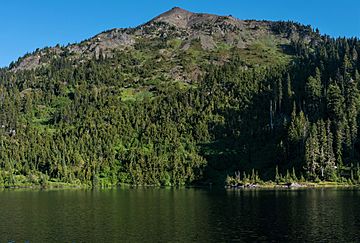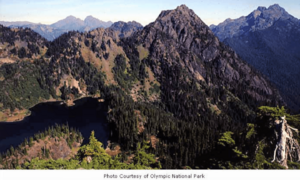Mount Lena (Washington) facts for kids
Quick facts for kids Mount Lena |
|
|---|---|

Mt. Lena, southeast aspect
|
|
| Highest point | |
| Elevation | 5,995 ft (1,827 m) |
| Prominence | 1,035 ft (315 m) |
| Isolation | 3.33 mi (5.36 km) |
| Parent peak | Mount Stone (6,612 ft) |
| Geography | |
| Location | Olympic National Park Jefferson County, Washington, US |
| Parent range | Olympic Mountains |
| Topo map | USGS The Brothers |
| Climbing | |
| First ascent | Unknown |
| Easiest route | class 2 hiking |
Mount Lena is a mountain peak that stands 5,995 feet (about 1,827 meters) tall. It is located in the beautiful Olympic Mountains in Jefferson County, Washington state. This impressive summit is part of Olympic National Park. It sits right above Upper Lena Lake, about 1,500 feet higher than the lake's shore.
Mount Lena has a smaller peak nearby called East Peak, which is over 5,800 feet tall. Other mountains in the area include Mount Bretherton, Mount Stone, and The Brothers. Water from Mount Lena flows into the Duckabush River to the north and the Hamma Hamma River to the south. Many people enjoy hiking to the top of Mount Lena. The best time to visit is usually from July to September. The United States Board on Geographic Names has officially recognized this mountain's name.
Weather and Climate
Mount Lena is in a special climate zone called the marine west coast climate. This means it gets a lot of moisture from the Pacific Ocean. When weather systems from the ocean move towards the Olympic Mountains, the mountains force the air to rise. As the air goes up, it cools down and drops its moisture as rain or snow. This process is called Orographic lift.
Because of this, the Olympic Mountains get a lot of rain and snow, especially in winter. Winters are often cloudy. However, during the summer, high pressure systems over the Pacific Ocean bring clear skies. This makes summer a great time to visit. The snow here can be wet and heavy, which can sometimes lead to avalanche danger. The months from June to September usually have the best weather for exploring Mount Lena.
Mountain Building
The Olympic Mountains are made from ancient ocean floor rocks and other materials that were pushed up over time. These rocks are mostly sandstone and a type of volcanic rock called basalt. Over many thousands of years, during the Pleistocene era (the Ice Age), huge glaciers moved across the land. These glaciers carved and shaped the mountains we see today. They advanced and retreated many times, slowly sculpting the landscape.




